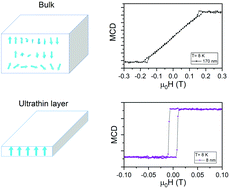Hard ferromagnetic behavior in atomically thin CrSiTe3 flakes†
Abstract
The research on two-dimensional (2D) van der Waals (vdW) magnets has promoted the development of ultrahigh-density data storage and nanoscale spintronic devices. However, the soft ferromagnetic behavior in most 2D magnets, which means the absence of remanent magnetization, severely limits their applications in realistic devices. Here, we report a layer-controlled ferromagnetic behavior in atomically thin CrSiTe3 flakes, where a transition from the soft to the hard ferromagnetic state occurs as the thickness of samples decreases down to several nanometers. Phenomenally, in contrast to the negligible hysteresis loop in the bulk counterparts, atomically thin CrSiTe3 shows a rectangular loop with finite magnetization and coercivity as the thickness decreases down to ∼8 nm, indicative of a single-domain and out-of-plane ferromagnetic order. We find that the stray field is weakened with decreasing thickness, which suppresses the formation of the domain wall. In addition, thickness-dependent ferromagnetic properties also reveal a crossover from 3 dimensional to 2 dimensional Ising ferromagnets, accompanied by a drop of the Curie temperature from 33 K for bulk to ∼17 K for the 4 nm sample. Our study paves the way towards exploring and learning much more about atomically thin and layered intrinsic ferromagnets.



 Please wait while we load your content...
Please wait while we load your content...